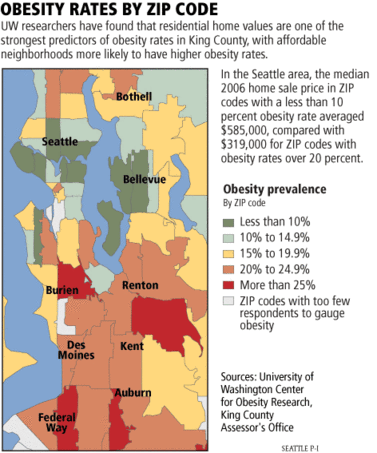 I found this article by the Seattle PI very interesting. Before moving to West Seattle (10-14% obesity zip code), I lived on North Lake in the West Hill neigh- borhood of Auburn (a more than 25% obesity zip code).
I found this article by the Seattle PI very interesting. Before moving to West Seattle (10-14% obesity zip code), I lived on North Lake in the West Hill neigh- borhood of Auburn (a more than 25% obesity zip code).
Living at North Lake meant that I planned my groceries because it was a bit of a trek to make it to QFC (which is now gone). The produce and meats were pretty good quality. The neighborhood also had other low cost grocery stores. I felt that QFC, at the time, offered the highest quality. There was (is?) a Trader Joes, for some reason, I didn’t shop there.
Living in West Seattle, we currently have several grocery stores, including Metropolitan Market and PCC. Whole Foods is coming soon (it’s rumored that Trader Joes will follow). With so many stores, I find myself shopping for groceries every day for that nights meal. The grocery store is an almost retreat like a pleasant break in my day. Metropolitan Market has great samples of cheeses and the kiosk is always cooking up something great. The produce and meats are very fresh. (When I lived in Des Moines, I loved going to the local butcher, B&E Meats over the grocery store).
Where my home was located in West Hill Auburn, we had a lot of Weyerhauser walkers (North Lake is next to Weyerhauser’s corporate headquarters)…admittedly, I was not one of them. I do get out and walk more living in West Seattle. In fact, this is a much more "active" neighborhood than my former. You have to be mindful opening your car door or you just might nail a bicyclist. Joggers, walkers and people with strollers cover the sidewalk.
The study, which followed 9000 King County residents boils down to:
- Access to fresh healthy foods.
- Cost of fresh healthy foods and organics compared to canned and other processed foods.
- Education about different types of food and reading labels. One example in the article which surprised me, is that raisin bran was less healthy than frosted mini-wheats.
- Walkable neighborhoods (sidewalks, safety, etc.)
To read the entire article, click here.
UPDATE: Hat tip to Lisa Wallace-Baker who just told me about Walk Score which "grades" how walkable your neighborhood is. My West Seattle neighorhood scored 32 out of 100 and my former Auburn scored a 15.








Please leave a reply